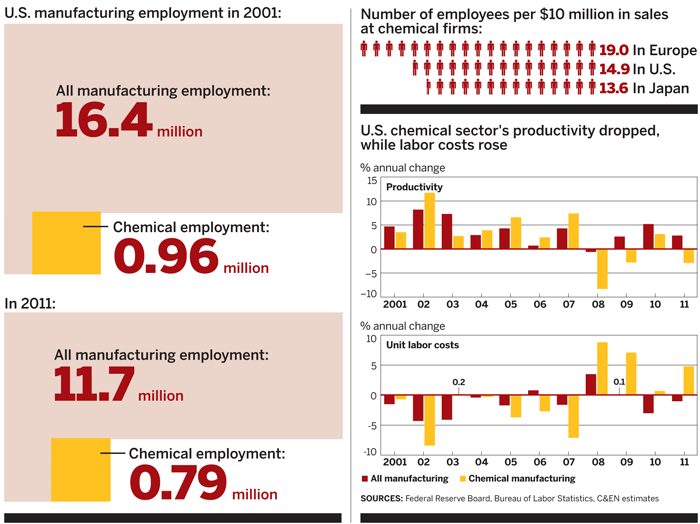Advertisement
Grab your lab coat. Let's get started
Welcome!
Welcome!
Create an account below to get 6 C&EN articles per month, receive newsletters and more - all free.
It seems this is your first time logging in online. Please enter the following information to continue.
As an ACS member you automatically get access to this site. All we need is few more details to create your reading experience.
Not you? Sign in with a different account.
Not you? Sign in with a different account.
ERROR 1
ERROR 1
ERROR 2
ERROR 2
ERROR 2
ERROR 2
ERROR 2
Password and Confirm password must match.
If you have an ACS member number, please enter it here so we can link this account to your membership. (optional)
ERROR 2
ACS values your privacy. By submitting your information, you are gaining access to C&EN and subscribing to our weekly newsletter. We use the information you provide to make your reading experience better, and we will never sell your data to third party members.
Business
A Mixed Picture For Chemical Jobs
Employment grew in Europe and Japan, but not in the U.S.
by Michael McCoy, Senior Correspondent Marc S. Reisch, Senior Editor Alexander H. Tullo (all three in C&EN's Northeast News Bureau), and Senior Correspondent Jean-FranÇois Tremblay (Hong Kong). Senior Editor Melody Voith
July 6, 2009
| A version of this story appeared in
Volume 87, Issue 27

Employment at Canadian, European, and Japanese chemical firms tracked by C&EN increased in 2008. In the U.S., employment at surveyed companies decreased only slightly.
COVER STORY
A Mixed Picture For Chemical Jobs
The data seem counterintuitive, considering that 2008 saw the worst recession that hit the global economy since the Great Depression. But during the year, economists reminded us many times that employment is a trailing indicator of the overall economy. That means there is significant lag time between a downturn in production and a corresponding decrease in workers. Indeed, the graph of U.S. labor costs shows that the chemical workforce became rather expensive in 2008, given the decrease in production.
Employers are slow to lay off workers when demand drops, in case the decline is temporary. To hold on to skilled labor, firms try to cut costs in other ways, like shrinking their pool of working capital, selling unused assets, cutting benefits, and even forgoing raises and executive bonuses.
And yet, a huge number of people in the U.S. lost their jobs in 2008. According to the U.S. Department of Labor's Bureau of Labor Statistics, the country lost more than 3 million nonfarm jobs. Manufacturing employment shrank by 3.2%, whereas chemical employment decreased by only 1.3%. The chemical job losses in 2008 were steeper than in 2007, and the overall trend is one of a slow but inexorable decrease.

Some chemical companies reported employment increases because of acquisitions. In the U.S., PPG Industries gained 10,000 employees when it acquired SigmaKalon. Canadian fertilizer producer Agrium added 4,400 people to its workforce when it bought fertilizer retailer UAP. And in Europe, AkzoNobel's purchase of ICI brought 17,400 workers to its payroll. Because the new workers were already employed in the chemical industry, the acquisitions do not actually increase the size of the chemical workforce.
In Japan, employment at major companies rose overall, but the per-company picture was mixed. At Sumitomo Chemical, headcount rose by more than 1,300, aided by the start-up of its Rabigh petrochemical venture in Saudi Arabia during the year. Mitsubishi Chemical took on about 2,500 employees from absorbing a pharmaceutical subsidiary into its operations. By contrast, DIC and Shin-Etsu Chemical reduced their headcounts.
As the year drew to a close, many chemical firms announced layoffs that didn't show up in 2008 data. BASF kicked off the trend on Nov. 19 with temporary facility closures and output reductions that affected 20,000 employees. Layoff announcements soon followed from DuPont, Dow Chemical, Eastman Chemical, Chemtura, Arkema, DSM, Air Products, and LyondellBasell, among others. Pharmaceutical firms, including AstraZeneca, Pfizer, and Bristol-Myers Squibb, also cut jobs starting in November.
Many end-of-year layoffs were of production workers, as companies around the world idled or shut plants. But for 2008 as a whole, the number of U.S. production workers actually increased by 2% after nine years of consistent declines. The biggest increases were in basic chemicals and agricultural chemicals. The only segment that employed fewer production workers in 2008 was paints, coatings, and adhesives, where jobs fell 2.6%. Production of many chemicals used in building materials slowed as the long slide in real estate values led to a decline in new construction.
Weekly pay for U.S. production workers decreased by almost $11, as companies cut back slightly on hours. But as chemical producers reduced output, productivity fell, a sharp reversal after many years of productivity improvements.



Join the conversation
Contact the reporter
Submit a Letter to the Editor for publication
Engage with us on Twitter